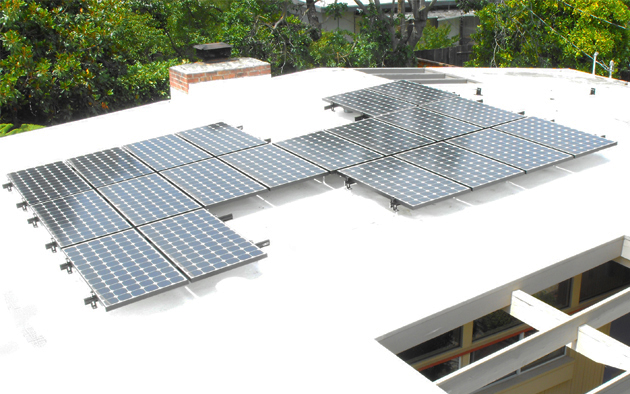
Ask an Expert: Buying Versus Leasing Solar Arrays
 |
|
|
With summertime approaching and PG&E bills ever on the rise, many environmentally aware Eichler owners are considering adding solar to offset or eliminate their bill for electricity.
More and more of them are choosing to work with companies that install and own the solar arrays, then sell the power they produce to homeowners, rather than the homeowners owning the solar arrays themselves.
Solar companies that provide these lease arrangements promise lower monthly electric bills and freedom from upfront costs. They also promise to maintain the arrays.
But Randy Feriante, whose Menlo Park firm, Dura-Foam Solar Center, has been working on Eichlers for 34 years, installing foam roofs and solar, urges potential solar buyers to think twice before entering into any solar lease arrangement.
“I think it’s a bad deal,” Feriante says of lease arrangements. He argues that, with the 30 percent federal tax credit for the purchase of solar installations, homeowners would do better by owning their arrays.
“If you can get reasonable financing you can buy [the solar array], and within a short period of time you’ve paid for it and you own it, and your energy is free after that.”
A solar array for a typical Eichler house would cost in the range of $10,000 to $15,000 after rebates and a 30 percent federal tax credit. It would cost more if there’s a pool pump or electric car to charge, he says. Two kilowatts of electricity will power an electric car 40 miles a day, Feriante says -- an average commute.
Under a lease arrangement, he asks, “Who gets the tax credit? The company that installs the solar, not you. That’s 30 percent of the whole cost, which goes a long way towards making [the system] pay for itself.”
The issue of the tax credits can be complicated, Feriante notes. Once the original lease contract expires, homeowners can purchase the solar installation and in some cases could take advantage of the tax credit then.
“Eichler owners need to look carefully at any solar agreement and see who is getting the tax credit and who will be responsible for future problems with the roof under the solar installation,” he says.
“In general, solar is pretty maintenance free,” he says, “except they have to drill 30 to 50 holes in your roof. You really need to ask, who is going to take care of any problems that develop?”
Maintenance is a particular issue for flat-roofed Eichlers and other flat-roofed modern homes. “The flat roofs are a lot more risky,” he says. “A flat roof will leak where a sloped one won’t.” Proper installation, however, can prevent or minimize leaks, he says.
Before signing a lease, he says, “read the contract carefully. Don’t depend on what the website or salesman says.”
It is difficult to predict how quickly an investment in solar will pay for itself. “Solar depends on the weather,” Feriante says, “and your usage depends on your usage. Both of these things vary widely.”
Some websites and apps help would-be buyers calculate the payoff period, he notes, and says a system should pay for itself within eight to 15 years.
“Lots of people get electric cars,” he notes. “What if you could put something on your roof for a final cost of $10,000 to $15,000 out of your pocket, and what if you could produce all the gas you’ll ever need for your car? Of course you would do it.”
- ‹ previous
- 54 of 677
- next ›



